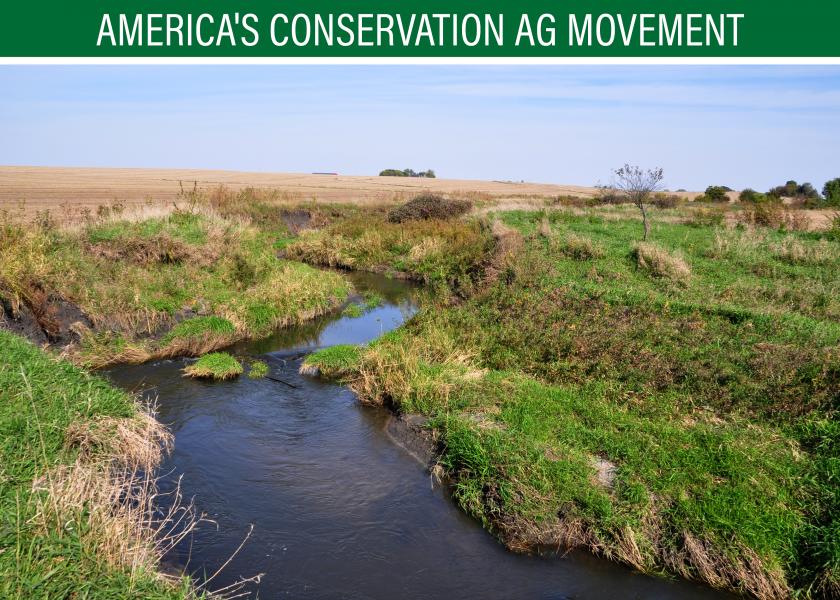10 Ways to Prioritize Water Quality

Building trust in food begins with empowering farmers through one of the largest and most diverse conservation- and sustainability-focused public-private partnerships in our nation’s history: America’s Conservation Ag Movement. To find the latest news and resources related to the Movement, visit AgWeb.com/ACAM.
Farmers commonly focus their attention on conservation planning by thinking through planning issues that deal with nutrient management, soil health or a particular problem spot on their farm. Water quality considerations naturally dovetail with many of these planning activities. Here’s how to make them more top-of-mind.
1. Know your watershed and its issues. Farmers feed the world, but that doesn’t gain many points in a culture increasingly removed from where their food comes from. Learn what problems exist in your watershed so you are in touch with your community’s concerns and can know how your operation might contribute to or mitigate those issues.
2. Follow the water. Know where your water comes from and where it goes. Look at every aspect of your farm and trace the water on, off, in and through. Think of your farm as a system, which exists within the watershed, which is also a system.
3. Take credit and continue to implement. Chances are many of the practices you do to mitigate soil erosion or improve soil health have a positive effect on water quality. Take credit for past conservation wins, but don’t stop there. Analyze where tweaks in production practices might positively impact water quality without much additional effort.
4. Get help and be open to overhaul. If you’ve got an area on your farm that just isn’t working be open to turning your production system on it’s head – at least in small doses. Try something outside your comfort zone that experts or others have said work for them, and give it a solid try, even on a few acres. Recognize some practices will take more than one year to show results. However, if you’re outside your comfort zone, find one (or several) trusted adviser(s). For tips on how to choose a trusted adviser, see page 43-44 of the Resource Stewardship Planning guide.
5. Get involved and be open to partnership. According to the National Water Quality Inventory, 70% of lakes, reservoirs and ponds; 78% of bays and estuaries; and 55% of rivers and streams assessed in the U.S. are impaired by pollution and do not meet minimum water quality standards. There’s a high likelihood yours could be one of them. You live there and it’s your water too, so find out what is being done locally to protect water sources and get involved. It’s a good idea to have a voice in the process, and as a bonus, you’ll be more likely to hear about partnerships and projects that could have cost-share dollars available to help make production changes.
6. Know your data and test for water quality. Test your farm well, your tile drainage outlets and any surface water (ponds, streams, lakes and rivers) on or adjacent to your farm. Visit EPA to find out more information about proper testing procedures and to find a water-testing lab in your state.
“If you understand context you can make decisions with confidence,” says Andy Johnson, consultant for Miltrim Farms. “To do that you have to know your numbers. If you don’t know what they are and how they change over time or after a major event, you can’t move forward with any real ability to be effective. Too many farmers are afraid if their numbers are known they might be used against them. But if you don’t know your numbers you also can’t defend yourself and you’ll be painted with the same brush as everyone in your watershed.”
7. Recognize tradeoffs. When balancing the needs of your operation, sometimes water quality is sacrificed for greater efficiency, better soil health or profitability. All are necessary, but recognizing where decisions might be impacting water quality can help you be more nimble in navigating concerns.
8. Plan for extreme weather. Volatile weather patterns have become more pronounced in the past decade. Think through which strategies you’ll use when water is scarce and when it is abundant. How can extreme weather not only affect your operation but the water that enters and exits it?
9. Use technology. Advances in technology have brought down the cost of variable-rate technology, climate stations, water efficiency controllers, water sensors and drip irrigation. Some items that used to cost thousands of dollars now cost hundreds or even less. Often the costs can be recouped within a few years by efficiencies gained and sometimes there might be cost-share dollars available for early adopters. If it’s been a few years since you’ve investigated what technology is available to monitor precipitation, reduce water use or apply nutrients more precisely, it’s probably worth a talk with your local dealers to see what technology might benefit your operation.
10. Use a nutrient management plan. Nutrients, specifically phosphorus (P) and nitrogen (N) are the leading cause of impaired bodies of water in the U.S. While they’re necessary elements for crop production, walking through the particulars of a nutrient management plan is a worthwhile endeavor to tackle with a professional.







